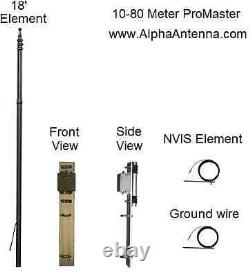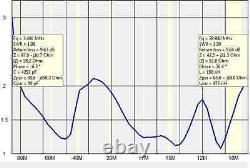
- Omni Directional Antenna
- Brand
- 1byone (54)
- Antop (92)
- Antop Antenna (78)
- Cisco (202)
- Comet (45)
- Digital Antenna (66)
- Five Star (58)
- King (197)
- Lava (47)
- Proxicast (47)
- Sennheiser (64)
- Shakespeare (119)
- Shure (46)
- Simplytech (44)
- Solarcon (82)
- Tram (48)
- Ubiquiti (55)
- Ubiquiti Networks (129)
- Ventev / Terrawave (61)
- Winegard (64)
- ... (3255)
- Directivity
- Isbn
- 0020572030113 (5)
- 0600358087366 (5)
- 0682604900421 (8)
- 0704725742497 (9)
- 0713091930537 (4)
- 0716837856849 (5)
- 0719441140557 (10)
- 0719441400026 (8)
- 0727932015611 (3)
- 0747742142598 (4)
- 0749755851719 (7)
- 0758763352163 (6)
- 0799637005686 (10)
- 0810209030452 (5)
- 0826713772955 (3)
- 0840449110874 (4)
- 0840449118061 (27)
- 0840449119631 (11)
- 0850021295219 (4)
- 6972173922530 (6)
- ... (4709)
- Model
- Type
- Adapter (6)
- Antenna (1109)
- Antennas (8)
- Boat Accessories (7)
- Condenser Microphone (10)
- Extender (16)
- Fiberglass Antenna (6)
- Hdtv Antenna (68)
- Lavalier (6)
- Network Antennas (12)
- Not Specified (7)
- Repeater (13)
- Rotator (6)
- Satellite (15)
- Satellite Dishes (8)
- See Description (19)
- Signal Boosters (6)
- Tv Antenna (78)
- Tv Reception (7)
- Wireless Controller (7)
- ... (3439)
- Weight
- 1.15 Pounds (4)
- 1.2 Pounds (8)
- 1.9 Pounds (7)
- 2.16 Pounds (5)
- 2.23 Pounds (10)
- 2.3 Pounds (4)
- 3.26 Pounds (4)
- 3.57 Pounds (7)
- 3.7 Pounds (4)
- 3.77 Pounds (4)
- 3.84 Pounds (5)
- 4.4 Pounds (4)
- 4.63 Pounds (5)
- 4.8 Pounds (4)
- 4.85 Pounds (12)
- 5.0 Pounds (7)
- 5.05 Pounds (5)
- 5.2 Pounds (14)
- 5.4 Pounds (10)
- 5.8 Pounds (3)
- ... (4727)
10-80 Meter ProMaster HF amateur ham radio base antenna




The ProMaster is a balanced limited space (permanent base or transportable) antenna that maximizes effective radiated power (ERP) while maintaining a SWR on 10-80 meters and Marine HF bands of less than 2.5:1. The on air experience of using this system is simultaneous omnidirectional NVIS and directional DX (reference the 3D Model below). Specifically, physically combining the Vertical aluminum mast and the 25 Horizontal wire element enhances high band directional DX (in the opposite direction the 25 wire NVIS element is run) and mainly omnidirectional low band NVIS. Please note that the NVIS element should not lay on the ground, but should slope away like a guy wire. Then too, the included Grounded Counterpoise wire and stake will run in the opposite direction of the wire NVIS element, and this grounding completes the balanced circuit at the antenna (Note - Without the ground there would be no path for current, which means that there would be an open circuit and the system would not work as efficiently). Simply install the antenna approximately 5 to 7 feet off the ground on any conductive or non-conductive mast and connect your coax to the SO239 on the included grey NEMA box. Frequency Coverage - 3.5MHz to 30MHz (Marine HF & 80 to 10 meters) Power - 250W PEP SSB, 125W CW, or 50W for sporadic use of digital modes 25W for continuous use of digital modes Weight - 9 Pounds. 1 Heavy duty mount and hardware - 1 Transformer inside an outdoor NEMA enclosure - 1 Self-supporting 6 section telescopic vertical element with 5 Stainless steel clamps - 1 25 foot NVIS Element - 1 8 foot Grounded Counterpoise wire & Ground stake. A low SWR across many bands is the nature of a well balanced OCF Dipole that often uses a 4:1 Balun. The ProMaster is, however, usable on many more bands because it: 1 provides a balanced RF ground via the included 8 grounded counterpoise wire, 2 enables balanced radiating elements with a 17 6 Vertical element and a 25 Horizontal wire element that both intersect and connect to the radiating side of a transformer, 3 then provides a feed-point with a SO239 for your feed-line that uses two of three connection points on a transformer, which are all enclosed in a high voltage outdoor rated NEMA enclosure. The result of this broadband design makes the ProMaster perfect for ALE (automatic link establishment) or military Digital Spread Spectrum Encrypted modes.
You may also use an external antenna tuner if either 1 the ProMaster is installed over a poor ground, 2 parallels a metal structure, 3 installed on a roof without adequate grounding, or 4 or not placed in a clear area. To be clear, losses on an OCF Dipole exist, which has a 4:1 Balun that begins to heat up as its transformer becomes saturated, where then too losses increase as the frequency is decreased. Similarly, the transformer in the ProMaster will also work to enable a SWR of 2.5:1 or less on the bands it is designed for. Yes, even a single band Dipole in free space will have loss as well due to resistance of the wire elements and due in part from a Balun that will be needed (unless ladder line is used) to change the naturally occurring (approximate) 72 ohms to 50 ohms, for which there will there will still not as much loss on lower bands as an OCF Dipole might experience due to the transformer that enables multi-band performance. And Yes, you should install a 10 Meter Dipole antenna 5 meters high to minimize losses, 10 meters high for a 20 Meter Dipole, and 20 meters high for a 40 Meter Dipole, but you get the idea.
The most popular way to get positive gain over a dipole is to install a beam on a tower, where like a Dipole, the beam would also need to be mounted in free space to minimize losses, yet would still have a Balun unless fed with ladder line. Speaking of ladder line, albeit less loss than coax (especially for longer runs), you will eventually need to use a tuner/Balun to convert it to 50 ohms, because that is what a modern day rigs input/output requires. What about a straight up Vertical, where of course you need to have real-estate to run the necessary radials? Well, Verticals usually work ok for DX, if you do not have obstructions around it. Although a Vertical is traditionally noisier, which causes it to suffer from higher RFI (Radio Frequency Interference), which can hide a weak signal...
And you often lose NVIS capabilities. The bottom line is that aerials built upon basic antenna construction techniques, like the ProMaster, will work. But what antenna should you choose? Alpha Antenna recommends that you might consider choosing an antenna based upon your band requirements, as well as your physical, personal, and your surrounding environment or restrictions.
If you simply want a 10-80 meter antenna that is pretty forgiving on how it is installed and works well for others, then the ProMaster may very well be the obvious choice for you. The ProMaster can be mounted on a tripod with a mast between 1 1/4 to 1 3/8 inches O. The base of the antennas Mount should not be installed below a height of 5 feet.
For example, it can be mounted on a galvanized top rail from a chain link fence or stainless steel mast, or the included 2 foot long aluminum mount can be bolted to a wooden fence post, optimally between 5 to 7 feet off the ground. Alternatively, the ProMaster can be roof mounted if you have a mast between 1 1/4 to 1 5/8 inches O. When mounting on a roof, the 25 NVIS Element can be tied off at an angle to a PVC vent pipe using an extra length of outdoor rated rope to the included green insulator after the aluminum stake is pulled from it. Then the ground wire can be tied off (with additional wire if needed) to your aluminum gutter or flashing at the edge of the shingles, either of which should provide enough of a ground plain.
We are dedicated to improving all of our antennas. Specifications and descriptions are subject to change without notice. The item "10-80 Meter ProMaster HF amateur ham radio base antenna" is in sale since Sunday, February 19, 2017. This item is in the category "Consumer Electronics\Radio Communication\Antennas\Ham, Amateur Radio Antennas".The seller is "alphaantenna" and is located in Pleasant Hill, Missouri. This item can be shipped worldwide.
- Model: ProMaster
- Country/Region of Manufacture: United States
- Band: HF
- Directivity: Omni-Directional
- Type: Antenna
- Compatible Product: Base Station Radio
- MPN: 861085000275
- Frequency Band(s): HF
- Brand: Alpha Antenna

